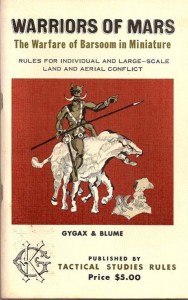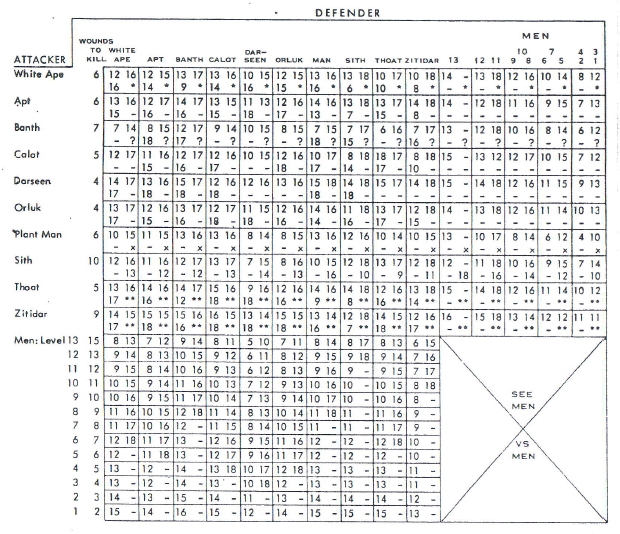During last night’s D&D game, DMed by original Greyhawk player Mike Mornard, we talked about a story I’d recently heard on an old episode of RadioLab, about a composer named Jonathan Cope. Cope wrote a computer program that could analyze the works of a classical composer – their musical intervals, chord progressions, and other patterns – and instantly generate new music in the same style: pastiche Bach, or pastiche Mozart. To my untrained ear, some of the music sounded pretty plausible. One faux-Beethoven piece sounded a lot like an alternate-history version of the Moonlight Sonata. (As Mornard noted when I told him the anecdote, Bach would be especially easy to analyze, since he was consciously playing number games in his music.) Other composers resist the idea of Cope’s computer-generated music, but Cope, I think, was acting on a respectful, loving desire to have more of the music he loved. I think that’s what gaming, fan fiction, and other forms of fandom are all about, at some level: the desire to understand the rules of the world you love, so that, for a little while, you can live there.
During our D&D game, we also talked about something seemingly unrelated: the upcoming John Carter movie. I’ve been a huge fan of Edgar Rice Burrough’s Martian books since I was a little kid, and I waver between a hesitant optimism and a fear that Hollywood’s Mars won’t live up to twenty-five years of memories. That’s a look into the soul of a pessimistic fan, the kind who just isn’t prepared to be happy.
Mike has a different attitude. “If I can see some Tharks tearing it up, I’ll be happy,” he says. That’s a look into the soul of a happy fan.
The Martian books are very influential on D&D and TSR, Mike reminded me. The original D&D books are rich with Martian references. The wandering monster tables contain references to the following monsters, all natives of Burroughs’ Barsoom: Thark, Thoat, Calot, White Ape, Orluk, Sith, Darseen, Apt, Banth, Red Martian, Black Martian, White Martian, and Yellow Martian.
(Sith? Banth(a)? Maybe Gygax wasn’t the only bearded 70’s sci-fi visionary to be influenced by Edgar Rice Burroughs.)
But the Martian creatures listed in Men & Monsters aren’t the extent of ERB’s influence on gaming. In the forward to Dungeons and Dragons, Gary writes, “Those wargamers who lack imagination, those who don’t care for Burroughs’ Martian adventures where John Carter is groping through black pits [or Leiber or Howard]… will not be likely to find DUNGEONS and DRAGONS to their taste.”
 That’s not all. TSR published a game about Mars, “Warriors of Mars”, IN THE SAME YEAR that they first published D&D. It was a sort of half-wargame, half-RPG, somewhere between D&D and the Chainmail system. Actual copies of the game are a rarity now: Burroughs’ estate sent TSR a cease and desist order, since Warriors of Mars was using Burroughs intellectual property, and TSR had to pull the game. The few remaining physical copies sell for hundreds of dollars.
That’s not all. TSR published a game about Mars, “Warriors of Mars”, IN THE SAME YEAR that they first published D&D. It was a sort of half-wargame, half-RPG, somewhere between D&D and the Chainmail system. Actual copies of the game are a rarity now: Burroughs’ estate sent TSR a cease and desist order, since Warriors of Mars was using Burroughs intellectual property, and TSR had to pull the game. The few remaining physical copies sell for hundreds of dollars.
Mike Mornard had a copy of Warriors of Mars: he sold it for something like three hundred dollars, I think. He mentioned that it might not have been the best game in the world. He thought that most of the mechanics were by Blume, and Gygax cleaned it up to make it playable.
For fun, here’s the combat system from Warriors of Mars. Look how easy to use!
Note that, besides the Martian monsters, the battle matrix contains numbers 1 to 13. Humans had levels, as they do in D&D. John Carter and all the heroes of the Mars books are statted up: John Carter is level 13. (If you play Heroes of Mars, your hero will never be stronger than John Carter.)
That cease and desist letter from the Burroughs estate, says Mike Mornard, was a key moment in the history of TSR. In a way, that’s when TSR stopped being an amateur hobbyist publisher and became a real company.
Before Gygax & co. got the letter from the Burroughs lawyers, they lived in a tiny niche: making little things for fellow fans. Their games were loving pastiches of Burroughs, Lieber, and Howard. Business-wise, there was limited upside to such a model. Normally, in those hobbyist publication circles, you printed up a few dozen or hundred pamphlets, and hoped to sell enough to break even. Big success meant you made enough of a profit to fund your next small-scale printing project. When TSR printed 1000 copies of D&D, Mike said, people thought they were crazy to print so many.
Today I feel an especially strong kinship with the guys at TSR, because my D&D poster kickstarter is driven by very much the same sort of loving pastiche, the same desire to inhabit the world, as I think inspired Warriors of Mars and Dungeons and Dragons. When TSR became a moneymaker, things changed: but at the beginning, I think Gygax, Blume and Arneson weren’t expecting to get rich making games. They wanted to experiment with the rules of their beloved fantasy worlds, and share their fan stuff with other people. I think I’d be crazy to expect to sell 1000 of my posters, but I’d love to think that a few hundred people out there will buy a poster, maybe play with it or put it up on a wall.
D&D fans know the next piece of TSR’s history. After the letter from the Burroughs estate and a similar kerfuffle with the Tolkien estate, TSR filed the intellectual-property serial numbers off of D&D, removing all references to thoats, hobbits, banths, and balrogs, and went on to become hugely successful. They did what every creative fan wants to do: they figured out the rules of their favorite fantasy worlds, so that they could make their own adventures.
Among rich, beloved fantasy worlds, D&D is unique. If you write Princess of Mars fanfic or play a Lord of the Rings role-playing game or a Star Wars video game, you’re playing in Burroughs’ or Tolkien’s or Lucas’s backyard. You’re embroidering the edges of the universe: you have to carefully avoid the swaths of canon created by Luke and Leia or Frodo and Sam or John Carter and the incomparable Dejah Thoris.
Playing D&D is different. It’s a fantasy milieu that’s just as detailed and inviting, and has as many rules to learn, as Mars, Middle Earth, or the Galactic Empire, but it has no pre-existing story for you to sidle around. It invites a kind of creativity that other milieu can’t. When TSR published the Dungeons and Dragons manuals, they were making something akin to Jonathan Cope’s composition software, but better. They let us write our own sonatas.
(Oops! I wrote an entire blog entry about playing D&D with Mike, and I didn’t include any gameplay! In another post I’ll write up a little about yesterday’s dungeon-crawl sonata.)









Might I direct your attention here, where you will find, nestled at the bottom of the page, “Dungeons & Dragons Warriors of Mars”, a fan-made pdf of the Barsoom setting for the original D&D whitebox ruleset (and their retroclones) which is based on TSR”s original Warriors of Mars game.
Sith? Banth(a)? Maybe Gygax wasn’t the only bearded 70’s sci-fi visionary to be influenced by Edgar Rice Burroughs.
The Mars novels also had Jeddak (king of the Tharks) – not too far off from Jedi.
Hmm, wouldn’t the Barsoom stuff be out of copyright now? I guess there’s not much stopping anyone from doing a new RPG or wargame based on it now.
There’s a new Barsoom movie just released — you bet your Darseen there is copyright. The Burroughs’ estate lawyers have always been elites.